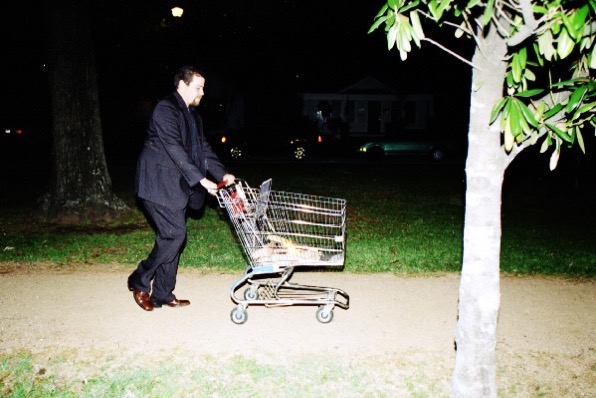Right, so, in my capacity as an Aged Nerd, GenX Uncle Chet now provides a sort of Dune Primer in advance of the upcoming film.
What is Dune?
Dune itself was the first of a series of books by Frank Herbert. It was published in 1965, and Herbert continued the story with several sequels until his death in 1986. The series has won basically every award they give in science fiction, and is truly one of the giants of the genre.
- Dune Messiah came in 1969.
- Children of. Dune came in 1976
- God Emperor of Dune, 1981
- Heretics of Dune, 1984
- Chapterhouse: Dune, 1985
Herbert’s son and collaborators continued the series after this point. I’ve only read through God Emperor, which is a place lots of people stop because at that point you’re thousands of years past the events of Dune itself, and it’s a point in the overall story where it’s easy to stop.
Prior Adaptations
Yes, Dune has been adapted before. David Lynch made a very flawed film in 1984, starring a then-unknown Kyle MacLachlan plus a long list of pretty serious actors (Patrick Stewart is in it; so is Jose Ferrer). It was also done on TV by the SyFy network in 2000, but that version is just unwatchably bad (and even so, they made a sequel that took them through Children, which is the only time I’m aware of anyone tried to adapt the works past the first novel).
Finally, much hay was made a few years back about a documentary made about Alejandro Jodorowsky’s attempt to adapt it in 1973. I’d love to have seen that!
The Universe
Dune is kind of unusual in highly inventive, very alien sci-fi in that it explicitly is about the far future of US, actual earthlings, not some other population of people unconnected to the present day (e.g., the Star Wars universe). The events of the story in Dune take place about 25,000 years from now. Humanity has dispersed to the stars, having at some point invented faster-than-light travel and a variety of other interesting technology.
Curiously missing from the Dune world is any trace of computing. This is because of a thing called the Butlerian Jihad, which happened long before the events of the book (like, 10,000 years; Herbert did some INSANELY DETAILED worldbuilding, akin to Tolkien, but you have to glean most if it from context). The result of the jihad was a broad and foundational prohibition on any thinking machines.
Space travel is complicated, obviously, so how do they do it without computers?
The Spice and the Guild
At some point in the distant past (relative to the story), humans discovered the desert planet Arrakis, also called Dune. Dune features the by-now-famous ENORMOUS sandworms, and is the only place in the universe where the spice melange is found. (There is an isolated population of humans there who are now effectively indigenous, but they truly arrived as a result of a long-ago sect of religious wanderers. They’re called Fremen, and play into our story as well.)
In 1965, it would’ve been a spoiler to disclose that the spice is produced by the enormous sandworms of Arrakis, but at this point it’s like knowing that a nasty baby alien is about to burst forth from John Hurt’s heaving chest in Alien.
Our characters don’t know this, though.
Melange is an addictive narcotic, but not a debilitating one. Additionally, it imparts some pretty amazing effects for some humans, among them mental expansion and ESP-like abilities; greatly increased lifespan; access to genetic memories; and eventual physical changes (the least drastic of which is one’s eyeballs turning blue).
Long-term exposure to the spice has allowed the Spacing Guild to unlock the secrets of manipulating something called the Holtzmann Effect, which is how interstellar travel happens in the Dune universe. The Guild has a complete monopoly on this; if you want to travel, you pay them. This puts them in a position of enormous influence, which in turn makes them a power effectively equal to the Emperor himself.
And, again, this spice is found in only one place in the universe, so control of Arrakis is a big damn deal. The spice is the single most important and valuable substance in the universe, and controlling it is to control pretty much everything.
Government
The Dune universe is effectively a multi-house feudal state. The emperor maintains power by playing the other houses against one another, with the cooperation of the Guild and other key players like the Bene Gesserit sisterhood.
Our hero is Paul, the son of Duke Leto Atreides, who has just been given control of Arrakis by the emperor. It’s a plum assignment, but it’s also a trap; the emperor is planning to allow the evil House Harkonnen to ambush the Atreides on Arrakis and eliminate them; Baron Harkonnen’s prize will be Arrakis and the production of spice (which, as noted, is a big deal).
Bene Whaterit?
The Bene Gesserit as a sorta-religious order of women who have their own mysterious agenda.
Spoiler: the agenda is to, via careful manipulation and court intrigue, bring about the culmination of a surreptitious breeding program and create the Kwisatz Haderach, or Shortening of the Way, a male Bene Gesserit figure they believe will lead humanity to salvation (“leading humanity to salvation” is a big theme in the books after Dune itself).
As the book begins, the order was poised to set up the final pairing: a daughter from Leto Atreides and his Bene Gesserit consort Jessica, who would eventually marry the heir of the evil Baron Harkonnen and produce the Kwisatz Haderach. Jessica, though, loves her duke, and knows Leto wants a son. One benefit of being a Bene Gesserit sister is near-total control of one’s body and chemistry, and so she gave him Paul instead.
This was unpopular with the sisters, since they believe Jessica has ruined their plans. What has truly happened, though, it will not surprise you to learn, is that Jessica jumped the line and bore the fruits of their program one generation early — and out of Bene Gesserit control.
The sisters have a host of quasi-supernatural abilities, including some precognition, genetic memories, etc., all associated with spice usage. They are also fearsome warriors, and possess abilities not seen in other groups such as the Voice, which allows a sister to give commands that cannot be disobeyed. There’s a certain amount of is-he-or-isn’t-he about Paul, and whether or not he can manifest these same abilities…
Important Characters
- Paul Atreides
- Son of Duke Leto and Lady Jessica; our focal character. A teen in the books, usually shown as a young man in adaptations. Played in both films by 25-year-old actors: the new film has Timothy Chalamet, and by Kyle MacLachlan in the 1984 film.
- Duke Leto Atreides
- Paul’s father and head of the ascendant and powerful House Atreides. Played by Jurgen Prochnow in 1984, and Oscar Isaac in the new film. I thought, when Isaac was cast, that he was too young, but the truth of it is he’s only about a year off the age Prochnow was in 1984 (Prochnow was 43; Isaac is 42). Given that Paul is supposed to be 17 or so, this works — though both Paul actors were older (25 for both).
- Lady Jessica
- The Bene Gesserit concubine to Duke Leto. I don’t think it’s ever made clear why she’s not his actual wife; Herbert does a lot of this with his characters — Paul eventually takes a noblewoman as his wife, but for political purposes only as his true love is Chani. This happens again a generation or two later. Francesca Annis played Jessica in 1984; up-and-comer Rebecca Ferguson has the role in 2021.
- Gurney Halleck
- Paul’s weapons teacher and House Atreides swordmaster. He’s also a gifted musician. Serves with Duncan Idaho and the Thufir Hawat as the Duke’s main advisory council. Patrick Stewart played Gurney in 1984; for 2021, we get Josh Brolin. (Also a good choice.)
- Duncan Idaho
- The other chief “knight” and retainer of the Atreides. Richard Jordan played him in 1984; Jason Momoa has the role now, which is a big shift but easy to envision.
- Thufir Hawat
- Unlike Halleck and Idaho, Hawat is not a fighter. He’s a mentat — a sort of human computer, fueled by (you guessed it!) spice — and master assassin. Freddie Jones was Hawat in 1984; master theater actor Stephen McKinley Henderson plays him today (you may have seen him in Devs).
- Baron Vladimir Harkonnen
- Head of the primary rival house. Transparently evil and scheming; they prize sadism and domination. Also a weak point for Herbert because he’s described as both corpulent and ugly, because bad guys have to be physically unappealing I guess. Kenneth McMillan in 1984; Stellan Skarsgard today.
- Glossu “the Beast” Rabban
- Baron Harkonnen’s sadistic and brutal — even by Harkonnen standards — nephew, and a key part of the Baron’s plot to destroy the Atreides on Arrakis. Possible heir to the Baron. Paul Smith in 1984; Dave Bautista today (which is another bit of great casting).
- Gaius Helen Mohiam
- Bene Gesserit reverend mother and head of the order; mentor to Lady Jessica. Spooky witch lady. Charlotte Rampling has the role in the new film, which makes perfect sense.
- Chani
- Half-Fremen woman — her father is the planetologist Liet-Kynes in the books; Kynes is gender-flipped in the new film — who becomes Paul’s lover and partner; eventually (after the events of the first book) mother of his children. Played by Sean Young (oooo, 1980s Sean Young!) in 1984, and by Zendaya today. GREAT casting.
- Stilgar
- Leader of the Fremen on Arrakis and ally to Paul after the fall of House Atreides. Really a great character in the books and on film. Everett McGill — who went on to be a frequent collaborator with Lynch — played him in 1984. We have Javier Bardem today. (Seriously, given the casting director a dang medal.)
Very Curious Omissions
- Feyd-Rautha Harkonnen
- The Baron’s younger nephew and actual heir. Whip-smart and conniving, and (for the Bene Gesserit) planned sire to the Kwisatz Haderach but for Jessica’s rogue choice. Played memorably by Sting in 1984 (there’s a knife fight at the climax) and as yet unknown in the new film. LOTS of hay has been made about his absence from any promo materials and casting lists. The most plausible reasons for their radio silence on this, a fairly pivotal character, are that (a) the new film doesn’t get deep into into the book to need him yet, and he’ll show up in a sequel; or (b) they’ve cast some hugely famous surprising figure and want to save the reveal until release. It would be SUPER WEIRD if he was just omitted entirely — like, unfathomably so.
- Alia Atreides
- Paul’s sister, who is only a small child in the events of Dune (and, in the sequels, comes to a bad end). Played by Alicia Witt in 1984, and as yet completely absent from any press about the new film. She has real things to do in the book, but (as with Feyd) if this film doesn’t finish the first book then her absence makes sense. She could also be written out entirely, but only if Villeneuve has no intentions of making sequels. (Her absence from any adaptations of the follow-up books would be harder to engineer.)




